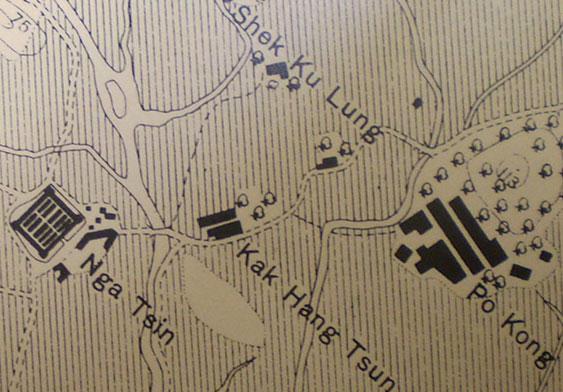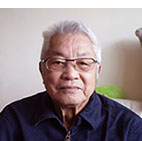
The now disappeared Shek Kwu Lung Village
This 1902 survey map from the Public Works Department shows Shek Ku Lung Village to the northeast of Nga Tsin Wai with a walking distance between the two of about 5 minutes-Extract from a government survey map on Kowloon in 1902, originally from Hal Empson, Mapping Hong Kong: a historical altas (Hong Kong: Government Printer, 1992).
The now disappeared Shek Kwu Lung Village
This 1902 survey map from the Public Works Department shows Shek Ku Lung Village to the northeast of Nga Tsin Wai with a walking distance between the two of about 5 minutes-Extract from a government survey map on Kowloon in 1902, originally from Hal Empson, Mapping Hong Kong: a historical altas (Hong Kong: Government Printer, 1992).
Life in Shek Kwu Lung Village with houses and farmland
Ng Sui Mo was born in Shek Ku Lung, a village adjacent to Nga Tsin Wai. His family included many members of his parent’s and grandparent’s generations. Back then, the family owned some big houses and farmland. As each dwelling had several halls, they were larger than typical village houses in Nga Tsin Wai. Each property also had a stove in its front hall; behind this was the living room, followed by a room and a cockloft. There were also spaces for sun-drying grains and a pig site. Ng Sui Mo lived with his grandfather, mother and siblings in such a house, with the old man sleeping in the living room. Ng Sui Mo also had several aunts and a grandmother who lived in the home of his eldest aunt. His eldest aunt grew flowers with her husband by the side of Shek Ku Lung Village. Whenever Ng Sui Mo’s mother was too busy to look after all of the children, Ng Sui Mo would go to his eldest aunt’s home with his grandfather to eat. While the old man had no real need to work, Ng Sui Mo’s mother earned her living by farming after she married to Shek Ku Lung. Sometimes he would help her to do farmwork. Their farmlands were acquired during the Japanese Occupation of Hong Kong.


 BACK
BACK  CLOSE
CLOSE 